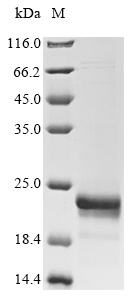Recombinant Human Fatty acid-binding protein (FABP5)
CAT:
399-CSB-EP007946HUe0-03
Size:
20 µg
Price:
Ask
- Availability: 24/48H Stock Items & 2 to 6 Weeks non Stock Items.
- Dry Ice Shipment: No




Recombinant Human Fatty acid-binding protein (FABP5)
- CAS Number: 9000-83-3
- Gene Name: FABP5
- UniProt: Q01469
- Expression Region: 1-135aa
- Organism: Homo sapiens
- Target Sequence: MATVQQLEGRWRLVDSKGFDEYMKELGVGIALRKMGAMAKPDCIITCDGKNLTIKTESTLKTTQFSCTLGEKFEETTADGRKTQTVCNFTDGALVQHQEWDGKESTITRKLKDGKLVVECVMNNVTCTRIYEKVE
- Tag: N-terminal GST-tagged
- Source: E.coli
- Field of Research: Cardiovascular
- Assay Type: Developed Protein
- Relevance: High specificity for fatty acids. Highest affinity for C18 chain length. Decreasing the chain length or introducing double bonds reduces the affinity. May be involved in keratinocyte differentiation.
- Purity: Greater than 90% as determined by SDS-PAGE.
- Activity: Not Test
- Length: Full Length
- Form: Liquid or Lyophilized powder
- Buffer: If the delivery form is liquid, the default storage buffer is Tris/PBS-based buffer, 5%-50% glycerol. If the delivery form is lyophilized powder, the buffer before lyophilization is Tris/PBS-based buffer, 6% Trehalose, pH 8.0.
- Reconstitution: We recommend that this vial be briefly centrifuged prior to opening to bring the contents to the bottom. Please reconstitute protein in deionized sterile water to a concentration of 0.1-1.0 mg/mL.We recommend to add 5-50% of glycerol (final concentration) and aliquot for long-term storage at -20℃/-80℃. Our default final concentration of glycerol is 50%. Customers could use it as reference.
- Function: High specificity for fatty acids. Highest affinity for C18 chain length. Decreasing the chain length or introducing double bonds reduces the affinity. May be involved in keratinocyte differentiation.
- Molecular Weight: 42.2 kDa
- References & Citations: "Exploring proteomes and analyzing protein processing by mass spectrometric identification of sorted N-terminal peptides." Gevaert K., Goethals M., Martens L., Van Damme J., Staes A., Thomas G.R., Vandekerckhove J. Nat. Biotechnol. 21:566-569 (2003)
- Storage Conditions: The shelf life is related to many factors, storage state, buffer ingredients, storage temperature and the stability of the protein itself. Generally, the shelf life of liquid form is 6 months at -20℃/-80℃. The shelf life of lyophilized form is 12 months at -20℃/-80℃.
